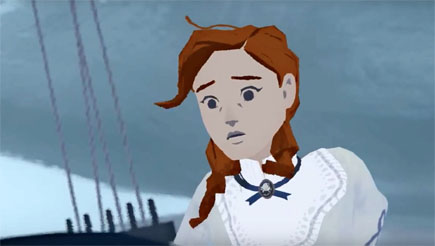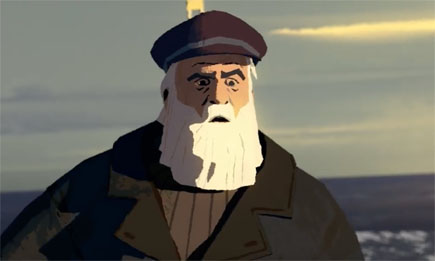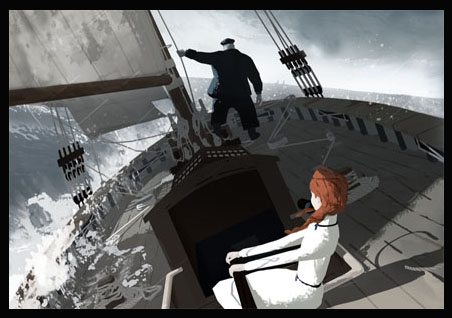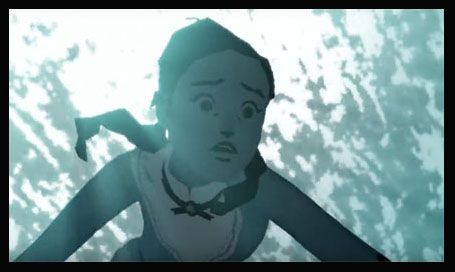
In 2013, John Kahrs won an Academy Award for directing the acclaimed Disney short film Paperman. His latest animated short is Google Spotlight Stories‘ VR experience, Age of Sail. Kahrs and I set sail for a Q&A on one of the year’s most ambitious animated efforts:
Jackson Murphy: This is a very specific story. It’s set in 1900 on the high seas. It’s basically a two-character study. Have you always been interested in this time period and sea adventure tales.
John Kahrs: I have. I grew up sailing. My dad built some sailboats and we sailed them on Lake Champlain. And I think that’s grown into a love of stories about the open ocean. And I really love the Horatio Hornblower series of novels. That’s one of the best – even more than “Master & Commander”. “Moby Dick”… even Mark Twain and the stories of riverboats. There’s a lot at stake when you’re on the water. There’s something fascinating about that.
And I guess I dig the whole turn of the turn of the century type thing. “Age of Sail” takes place at the turn of the century because I feel it’s like a crossing point for technology – where you’re going from the Age of Sail and you’re now completely into the age of mechanized steamships.

JM: And I think you can take the word “age” and interpret it in another way, too. You have these two characters, William Avery and Lara Conrad: older gentleman (the captain) and young girl. And the dynamic here of old people vs. young people – we see that in society today – how the different generations learn from each other. Was that a dynamic you really wanted to explore – these different age groups?
JK: Oh, yeah. Absolutely. I feel like all the layers of metaphor are in there. She’s coming of age, and she’s the next age. She’s the future. And he’s old, and the Age of Sail is coming to an end. And he’s someone that feels like he’s had a golden age, and that age has now passed him by. I felt like, “Is this too obvious?” when I was coming up with the title “Age of Sail” because people do know it as an expression… but it felt like it was resonant enough with the ideas in the story that it would be a very solid title.
JM: I congratulate you on “Age of Sail”. Much of it feels like a slice out of a feature-length movie.
JK: I appreciate that because my speciality is me trying to jam an entire feature-length film into a really short running time. And I think “Age of Sail” is sort of bursting at the seams. “Paperman” was like that. I did a short film for Lyft that feels more like that. I wanted “Age of Sail” to feel like it had that expansive feature film quality, like a David Lean – almost like a “Lawrence of Arabia” type space. Expansive spaces on the water and expansive themes. And I wanted to go for something a little deeper – a deeper reach into that cinematic experience.
JM: One of the most impressive elements for me was listening to the waves. How exactly did you get the right sound for the waves?
JK: The sound was Jamey Scott and the sound recording crew. They were very specific. We got on wooden boats. We took a very classic wooden boat, kind of from the time of Humphrey Bogart. It was called the Jada, down in San Diego. And that was a big part of getting the crew to experience what it is like to be on a vessel that’s driven by wind amongst the waves. They did a lot of sound recording on there, which is very realistic and accurate. That’s part of moviemaking – to push it so that it’s the stylized impression of that sound that you’re hearing, not just the technically accurate sound. The effort in doing that, and the detail…. discovering all that detail and bringing it into the short paid off.
I don’t like the idea of being on the water. I think there’s something about being immersed in the waves, like the troughs and the peaks. It’s like this rolling landscape. I felt like this is something that you want to feel immersed in – in a way that I feel like cinema sometimes doesn’t get really well. It’s either super flat and calm, because of the practicalities of shooting in the open water. Or it’s this cartoony, perfect storm, 150-foot wave. It’s so big that you can’t even get your head around it. But there’s this in-between state that I think is really fascinating where that is what the open ocean feels like to me, which is rolling across these big, rolling waves.

JM: And there’s definitely a unique style to these Google Spotlight Stories animated shorts, with the Virtual Reality aspect. How did that work with the lighting and the shadows?
JK: The darkness and the light are part of the metaphor of the storytelling of this guy being obscured, literally, by the shadow of this giant ship going by. And he lives in this shadowy place. When we started, the word on the street was, “John, you’re not gonna get shadows.” (laughs) We have to run in a real time environment. It’s really demanding. We have to use a low polygon kind of world. And there’s a limit on how realistic that world can be. But as somebody who has been around computer graphics since the late 80s/early 90s, I kind of know what it’s about and what the limits are and what you can do – and what you can’t do.
We did find some nice tricks. If we’re gonna use low poly characters, let’s turn that weakness into a strength. Let’s make designs that are harmonious with that crunchier… broken-edge angular thing. And then the shadows are something that Cassidy Curtis, who works at Google Spotlight Stories – he was like “Hmm… let me think about this.” And over time, he developed a very carefully tuned, right on the edge of what is capable, system for coming up with shadows. When you’re in… a live real-time game on your PS3 or PS4, those shadows are all faked. They’re all very carefully adjusted. It’s not like a rendering that you would do in traditional computer graphics. So that’s kind of what he was doing, too, but in a very careful way. So… we arrived at a really nice solution of getting that sense of being there and being amongst the light and the shadow.
JM: Definitely. And to add to the realism, you have a really big name, Ian McShane, voicing William Avery. And because he voiced Captain Hook in “Shrek the Third” and played Blackbeard in one of the “Pirates of the Caribbean” movies, I feel like this role was made for him – and a passion project for him.
JK: He was fantastic. First of all, when we stared it, the writer I was working with, Jonathan Igla, said “It’s gotta be Ian McShane.” Right out of the gate, he suggested that. And I was like, “Dude. That’s brilliant.” And then it never really wavered from that. But at the beginning, [Google] said “I don’t know if we’re gonna go for an actor that big. We don’t usually do that for these kinds of projects.” But I think over time, we kind of chipped away at the problem.
And the interesting thing about being in Hollywood and LA… when you call these people, they respond. And if the project is strong, they’re like, “Okay. Let’s do it.” And it just happens. Whether it comes to composers or actors or production designers: the people are there. The talent is there to work for you.
The first thing I got back from [McShane] was, “Who am I playing against?” And it’s this girl, Cathy Ang, who is this really great Chinese-American actress, who’s living in New York and has done a lot of stage work. So I made him a little video – this explanatory thing that told him all about his character and why he was perfect for it. And then I talked a lot about Cathy and why, because of her stage experience, she’s done a lot of Victorian dramas… I think she’s solid. The combination of toughness, vulnerability, the age, and she has the accent nailed. So I sent that to him.
And then he calls me… directly, which is really weird. When Ian McShane calls you, it’s like… [Kahrs does a McShane impression] “John, this is Ian McShane.” Oh my God, it’s Al Swearengen from “Deadwood” – he’s calling me directly. But then he shifted his tone to, “I’d be happy to do it. I think it’s a delightful project.” Almost like he was an old Beatle. He was just really happy that I took the time to explain all that and let him come to his own understanding of it. And from there, it was off and running.
By the time you get in the recording studio, and there’s nothing that is as inspiring as a deadline with a recording session with Ian McShane. It’s something that pushes you to make it as good as it can be, because you want it to be something that is deserving of his talent. But by the time you get to the recording studio, you’re just really getting out of the way and letting him kind of light it on fire because the thing is designed for him. He knows exactly what he’s doing, and you’re giving him a little bit of guidance. But really you’re just there for texture, and his age and experience. Obviously, I was very happy with his performance.

JM: The character has such gravitas, but he also has to walk a fine line. Early on, we see him drunk. He’s singing some sailor songs. Was there a tricky balance for you trying to make his character not be a stereotype of captains?
JK: Yeah. That’s an excellent question. No one’s actually asked me that before. The earlier versions of the script – he was much less likable. He was verbally really abusive. I softened him in the script as we went along. Another writer, Blaise Hemingway, helped me a lot with that. But by the time we got to the recording session, he was a little more like a teddy bear, cuddlier than I expected. And it kind of surprised me.
And this is one of the things that’s really magical about recording voices for animation: sometimes you hear something in a session that you’re like, “I don’t know. Is that gonna work?” And then later, when you go and you start animating against it, and you starting parsing through the detail, almost like a slow-motion process of unpacking that – the sound of the voice and what he’s doing there – it just became obvious to me that he was doing something really smart. He’s taking a character that, on the page, is unlikable, but he’s adding this softer, more appealing side to him. I think that was a wise move.
And I think Cathy also talked about when [Lara] is in the cabin, and she’s looking at his picture of his past, and when she comes up the next day to start confronting him, Cathy said, “You know there’s something about this guy… I understand what’s going on with him. But I kind of like him in a weird way.” He’s kind of a likable guy, even though on paper he’s unlikable. And I think those are the things that hopefully… by the time you see him come to life later, and he’s doing way more than you even knew he was capable of – because he’s been sitting there for five minutes, hardly moving – that by the time you get to that climactic chase scene, you feel like you’ve earned something. You’ve seen a character really go through a transformation and reveal this amazing capability inside him.
JM: So take me back to Oscar Night 2013. I watched your acceptance speech video again the other day. You got to sit in a section right to the side of the stage. And you received your Oscar from one of the nicest people in the biz, Melissa McCarthy. Did the evening live up to your expectations?

JK: It’s a huge honor just to even be in the running. And The Academy – they treat you like a king. Like royalty, right away. All the events leading up to it, and then the night itself, when you walk in, they’re just so welcoming. It was a wonderful experience. Honestly, going down the red carpet was totally surreal. And being in that little box, that was just a matter of TV programming efficiency, of shortening the physical distance between the nominees and the stage.
As far as actually getting it in my hand and speechifying, that was all really a blur. The thing that I do remember is that you kind of get whisked off stage and you go through all these mannered press stuff and official pictures. And then when I was finally done with that, I came back out during a commercial break, and I walked down to the front row of the audience. I got the Oscar and everyone’s just kind of standing around waiting for the commercial break to come to a close so the show can start again.
And Steven Spielberg was standing there… just standing there stretching his legs. And I was like… “I think this is the time.” (laughs)
JM: Make your move!
JK: Yeah. I’m holding an Oscar and wearing a tuxedo. “I just want to say that I’m a huge admirer. You’re such an inspiration.” And he was super nice. He was like, “Thanks. I appreciate that.” And then I went and sat down. And the rest of the night was a blur, too. It was very special.
JM: And your wife, Gennie Rim, was with you. And she’s actually a producer on “Age of Sail”. So how does that relationship work here?
JK: It’s working really well, and hopefully it’s going to continue because I think we are… our biggest supporters and our fiercest critics to each other. We try to keep that professional balance delineated from our personal lives, but we always try to be really honest with each other. It comes down to the respect that we have for each other – each in our own discipline is so much of a driving force in our professional relationship. I just think she’s excellent at what she does. I think she thinks I’m pretty good at what I do, too. I think we’re just always challenging each other and not accepting anything less than the best. When we’re working together, we always try to make it about the work, and I think that’s a healthy place to be. And I’m hoping to keep working with her.
You can watch the theatrical version of “Age of Sail” on the Google Spotlight Stories app and YouTube channel, the 360 mobile version on Google Play and ITunes – and the Virtual Reality version on Steam and Viveport. Kahrs will also be speaking at the CTN Animation Expo tomorrow night, November 16th, at 7pmPT.
- INTERVIEW: “Inside Out 2” Director And Producer On Pixar Sequel - April 16, 2024
- INTERVIEW: “Puffin Rock And The New Friends” And 25 Years Of Cartoon Saloon - April 10, 2024
- INTERVIEW: “Chicken For Linda!” Directors On Annecy Winning Feature - April 9, 2024


 November 15th, 2018
November 15th, 2018  Jackson Murphy
Jackson Murphy  Posted in
Posted in  Tags:
Tags: 






